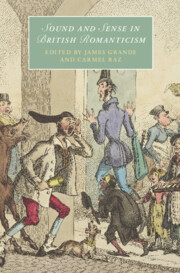Illustrations
2.1David Allan, James Erskine, Lord Alva, and His Family, 1780.
3.1Michael Angelo Rooker, The Scene-Painter’s Loft at the Theatre Royal, Haymarket, c. 1785.
3.3Edward Rooker after Michael Angelo Rooker, ‘The Horse-Guards’, from Six Views of London, 1768.
3.4James Stow after George Jones, ‘Interior of the Little Theatre, Haymarket’, 1815 (detail), from a series published by Robert Wilkinson, 1825.
5.1Isaac Cruikshank, ‘The Enraget [sic] Politician or the Sunday Reformer or a Noble Bellman Crying Stinking Fish’, 1799.
7.1Image accompanying the echo measurement in Robert Plot, The Natural History of Oxford-Shire (1677), 17.
7.2Detail from letter from Gilbert White to Samuel Barker and Anne Barker, 30 March 1775.
9.1The keyboard and pedalboard for Liston’s ‘euharmonic organ’. Each of the keys is in natural tuning (or in technical terms, five-limit just intonation).
9.2St Andrew’s Church in Tank Square, Calcutta, c. 1826, from James Baillie Fraser, Views of Calcutta and Its Environs, plate 13.
9.3Farey’s table of Liston’s tuning system, from two perspectives, as described in Farey, ‘On Mr. Liston’s, or the Euharmonic Scale of Musical Intervals,’ 443.
9.4The connection between the European diatonic scale and the ‘Indian scale’ composed of twenty-two śrutis, as per Captain N. Augustus Willard, William Jones, and J. D. Paterson.
9.5Krishnaji Ballal Deval’s ‘Indian Harmonium,’ from Henry Keatley Moore, ‘Indian Harmonium,’ patent application GB 15548, filed July 4, 1911, issued December 12, 1911.
9.6A diplomatic transcription of G. S. Khare’s diagram of the twenty-two śrutis.
10.2William Davey, The Illustrated Practical Mesmerist, Curative and Scientific (Edinburgh: William Davey, 1854), plate 2.

